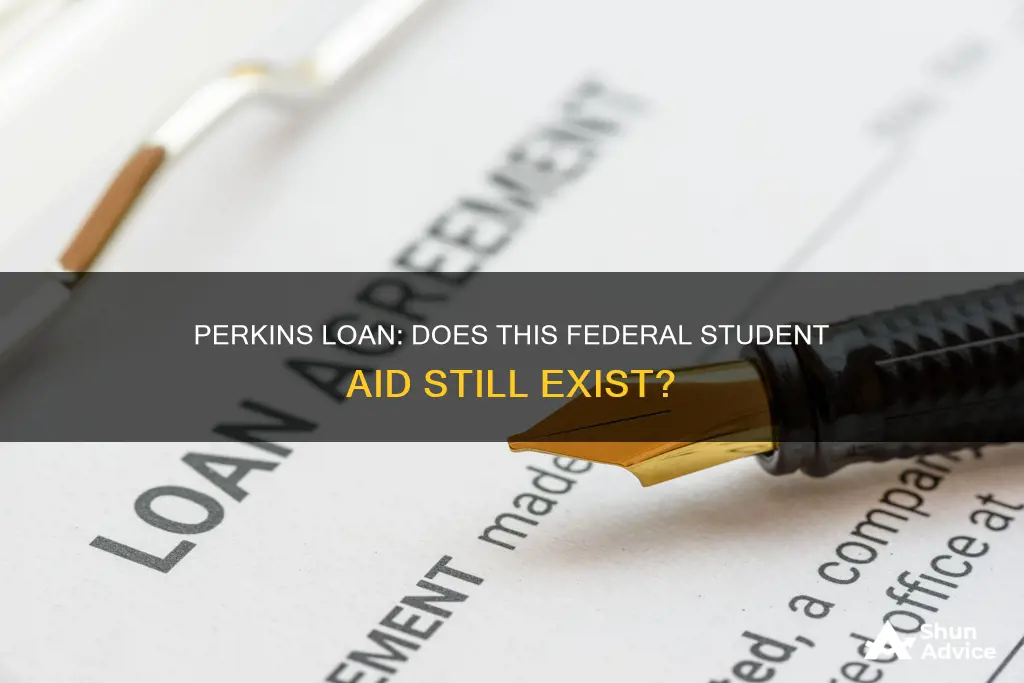
The Perkins Loan Program was a US federal government initiative that provided low-interest loans to undergraduate and graduate students with significant financial needs. The program ended in 2017, but existing Perkins loans are still eligible for many forms of federal student loan forgiveness. As of 2023, Perkins loans account for $3.7 billion in federal student debt held by 1.2 million borrowers. So, does the Perkins Loan still exist?
| Characteristics | Values |
|---|---|
| Does Perkins Loan still exist? | No, the Perkins Loan Program ended in 2017. |
| Who offered the Perkins Loan? | The loan was offered by the U.S. government and was available through schools. |
| Who was eligible for the Perkins Loan? | Undergraduate and graduate students with significant financial need, as assessed by institutional guidelines and the FAFSA form. |
| What was the interest rate on Perkins Loans? | The fixed interest rate was 5%. |
| How much could students borrow with Perkins Loans? | Undergraduate students could borrow up to $27,500, and graduate students could borrow up to $60,000. |
| What is the repayment period for Perkins Loans? | Perkins Loans must be repaid within 10 years. |
| Are there any loan forgiveness options for Perkins Loans? | Yes, borrowers may be eligible for loan forgiveness if they work in public service jobs or consolidate their loans through the Public Service Loan Forgiveness (PSLF) program. |
| What are the current federal loan options for students? | Direct subsidized loans, direct unsubsidized loans, direct plus loans, and direct consolidation loans. |
What You'll Learn

The Perkins Loan Program ended in 2017
The Perkins Loan Program, which provided low-interest loans to students with exceptional financial need, ended in 2017 due to budgetary reasons and calls for a streamlined federal student loan program. The federal government discontinued the program on September 30, 2017, with the last funds disbursed in June 2018.
The Perkins Loan was a unique financial aid program initiated in 1958, offering a fixed 5% interest rate and a longer grace period of nine months compared to other student loans. Undergraduate borrowers were limited to $5,500 per year, with a cumulative limit of $27,500, while graduate students could borrow up to $8,000 per year with a total limit of $60,000. The money for the loans came primarily from the government, but approximately 1,700 schools also contributed a portion.
Despite the end of the program, people who received Perkins Loans are still required to repay them and are eligible for loan forgiveness programs. Perkins Loans must be repaid within ten years, and borrowers employed in public service jobs may be eligible for loan cancellation or forgiveness. It's important to note that the school that issued the Perkins Loan can provide specific instructions and applications for loan forgiveness.
Although Perkins Loans are no longer available, there are other funding options for students who demonstrate financial need, such as the Federal Pell Grant and the Federal Supplemental Educational Opportunity Grant. These grants do not need to be repaid and are aimed at undergraduate students facing financial challenges.
OSLA Deferment Options: What You Need to Know
You may want to see also

Perkins Loans have a fixed 5% interest rate
The Perkins Loan Program was a federal loan program that offered low-interest loans to undergraduate and graduate students with significant financial needs. The program was discontinued in 2017, but borrowers who still hold Perkins loans must repay them.
Perkins Loans have a fixed interest rate of 5%. This means that borrowers will not pay or accrue any interest while they are in school or during the nine-month grace period following graduation. After this grace period, borrowers will begin to repay their loans with the fixed 5% interest rate. The maximum repayment term for Perkins loans is 10 years.
The interest rate for a Perkins Loan is lower than the interest rates for other federal loans, such as Direct Subsidized Loans and Direct Unsubsidized Loans, which have interest rates of 6.53% and 8.08%, respectively. Perkins Loans are also different from other federal loans in that the school is the lender. This means that borrowers must work with their school or a company hired by their school to repay their Perkins Loans.
The amount that students could borrow under the Perkins Loan Program was limited. Undergraduate students could borrow up to $5,500 per year, for a total of $27,500, while graduate students could borrow up to $8,000 per year, with a maximum of $60,000 for both undergraduate and graduate Perkins Loans combined.
Commercial Plate Ownership: Impact on Loan Eligibility
You may want to see also

Perkins Loans are eligible for federal student loan forgiveness
The Perkins Loan Program, which offered low-interest loans to undergraduate and graduate students with financial needs, ended in 2017. However, borrowers who still hold Perkins loans must repay them. As of the second quarter of 2023, Perkins loans accounted for $3.7 billion in federal student debt held by 1.2 million borrowers.
To apply for Perkins loan forgiveness, borrowers should contact the school that originally made the loan or the student loan servicer that handles their loan account to obtain the necessary forms. It is important to note that refinancing or consolidating Perkins loans may make them ineligible for future forgiveness. Therefore, borrowers should carefully consider their options and explore the available federal programs before making any decisions.
Additionally, the U.S. government offers several income-driven repayment (IDR) plans that may lead to loan forgiveness after a certain period. These plans allow borrowers to cap their loan payments at a percentage of their monthly income, and in some cases, eligible borrowers may even pay nothing towards their loans. The SAVE plan, introduced by the Biden Administration, is one such example, although it has been blocked by a federal appeals court as of July 2024.
Title Searches: PennyMac's Loan Modification Process Explained
You may want to see also

Perkins Loans are repaid to the school
The Perkins Loan Program was a federal loan program that offered long-term, low-interest loans to undergraduate and graduate students with significant financial needs. The program was initiated in 1958 and ended in 2017 for budgetary reasons and due to calls for a more streamlined federal student loan program. The last Perkins loan funds were disbursed in June 2018.
Perkins loans were granted through the financial aid office of the student's educational institution, with money paid directly to the student. The school was the lender, and the loan was repaid to the school. The borrowing limits were determined by the student's financial needs and the school's funding availability. Undergraduates could borrow up to $5,500 annually, with a total limit of $27,500, while graduate students could borrow up to $8,000 annually, capped at $60,000.
Repayment of Perkins loans typically began nine months after the student graduated, left school, or dropped below half-time status. The longest repayment term for Perkins loans is 10 years, with a 5% interest rate. However, part or all of the loan could be deferred or cancelled under certain conditions, such as teaching children with disabilities or teaching full-time in a designated low-income school.
Borrowers employed in public service jobs, such as teaching or nursing, may be eligible for student loan forgiveness programs or loan cancellation after a certain number of years of service. The school that issued the Perkins loan can provide specific information and applications for loan forgiveness.
Boat Loans: One Main Financial's Marine Financing Options
You may want to see also

The Federal Government ended the Perkins Loan Program for budgetary reasons
The Federal Perkins Loan Program was a US government-backed financial aid program that offered low-interest loans to undergraduate and graduate students with significant financial needs. The program was initiated in 1958 and ended in September 2017, with the last funds disbursed in June 2018. The federal government ended the program primarily for budgetary reasons and due to calls for a more streamlined federal student loan program.
The Perkins Loan Program provided loans with a fixed interest rate of 5%, which was paid by the federal government while borrowers were still in school. Qualifying applicants could borrow up to $27,500 as an undergraduate student and up to $60,000 as a professional graduate student pursuing a master's degree. The loans were granted through the financial aid office of the student's educational institution, with money paid directly to the student or to the school.
While the Perkins Loan Program has ended, there are still outstanding Perkins loans. As of the second quarter of 2023, these loans account for $3.7 billion in federal student debt held by 1.2 million borrowers. Borrowers are still required to repay these loans within ten years. However, those employed in public service jobs, such as teachers or nurses, may be eligible for loan forgiveness after a certain number of years of service.
The US government currently offers other federal loan options for students, including direct subsidized and unsubsidized loans, often called Stafford loans. Additionally, the White House launched the Saving on a Valuable Education (SAVE) Plan, which is an income-driven repayment plan offering benefits such as reduced monthly payments and the elimination of capitalized interest.
Ocwen's Loan Origination: What You Need to Know
You may want to see also
Frequently asked questions
No, the Perkins Loan Program ended in 2017.
Yes, you still have to pay back your Perkins Loan. Perkins Loans are no longer offered, but borrowers who still hold one must repay the loan.
Yes, Perkins Loans are eligible for many forms of federal student loan forgiveness. Borrowers employed in public service jobs may be eligible to have their loans canceled.
As a qualifying applicant for a Perkins Loan, you could borrow up to $27,500 as an undergraduate student and up to $60,000 as a professional graduate student pursuing a master's degree.







